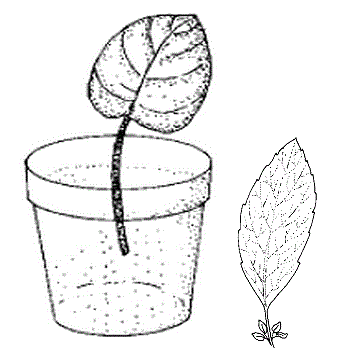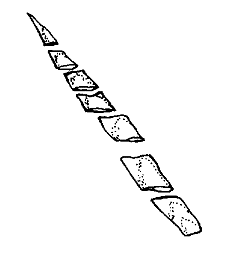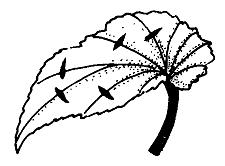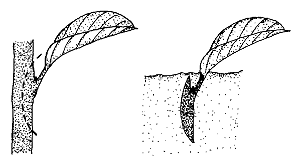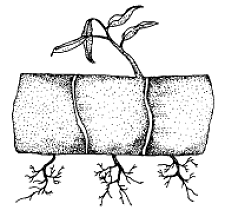Leaf Cuttings
Some, but not all, plants can be propagated from just a leaf or a section of a leaf. Leaf cuttings of most plants will not generate a new plant; they usually produce only a few roots or just decay. Because leaf cuttings do not include an axillary bud, they can be used only for plants that are capable of forming adventitious buds. Leaf cuttings are used almost exclusively for propagating some indoor plants. There are several types of leaf cuttings.
Leaf-petiole
Remove a leaf and include up to 11⁄2 inches of the petiole. Insert the lower end of the petiole into the medium (Figure 1). One or more new plants will form at the base of the petiole. The new plants are then severed from the original leaf-petiole cutting and the cutting may be used once again to produce more plants. Examples of plants that can be propagated by leaf-petiole cuttings include African violet, peperomia, episcia, hoya, and sedum.
Leaf without a Petiole
This method is used for plants with thick, fleshy leaves. The snake plant (Sansevieria), a monocot, can be propagated by cutting the long leaves into 3- to 4-inch pieces. Insert the cuttings vertically into the medium. African violet, a dicot, can also be propagated from the leaf blade itself. Cut a leaf from a plant and remove the petiole. Insert the leaf vertically into the medium making sure that the midvein is buried in the rooting medium (Figure 2). New plant(s) will form from the midvein.
Split-vein
Detach a leaf from a rex begonia and remove the petiole. Make cuts on several prominent veins on the underside of the leaf (Figure 3). Lay the cutting, lower side down, on the medium. If the leaf curls up, hold it in place by covering the margins with rooting medium. New plants will form at each cut. A variation of this method is to cut the leaf into wedges, so that each piece has a main vein. The leaf wedge should be inserted into the media with the main vein partially covered.
Leaf-bud Cuttings
Leaf-bud cuttings are used for many trailing vines and when space or cutting material is limited. Each node on a stem can be treated as a cutting. This type of cutting consists of a leaf blade, petiole, and a short piece of stem with an attached axillary bud. Place cuttings in the medium with the bud covered (1⁄2 to 1 inch) and the leaf exposed (Figure 4). Examples of plants that can be propagated in this manner include clematis, rhododendron, camellia, jade plant, rubber plant, devil’s ivy, grape ivy, dracaena, blackberry, mahonia, and heart-leaf philodendron.
Cane Cuttings
Cane cuttings provide an easy way to propagate some overgrown, leggy house plants such as dumbcane, corn plant, Chinese evergreen, and other plants with thick stems. Leafless stem sections (2 to 3 inches long) are cut from older stems. Each cane should have one or two nodes (Figure 5). Lay the cutting horizontally on the medium, or insert it vertically with about half of the cutting below the surface of the medium, and leave a bud facing upward. Cane cuttings are usually potted when roots and new shoots appear.
Root Cutting
Some plants can be propagated from a section of a root. Root cuttings of woody plants are usually taken from plants during the dormant season, when carbohydrate levels are high. Root cuttings of some species produce new shoots, which then form their own root system, whereas root cuttings of other plants develop root systems before producing new shoots. Examples of plants that can be propagated from root cuttings include raspberry, blackberry, rose, trumpet vine, phlox, crabapple, fig, lilac, and sumac.
Plants with large roots are normally propagated outdoors. The root cuttings should be 2 to 6 inches long. Make a straight cut on the proximal end (nearest the crown of the parent plant) and a slanted cut on the distal end (furthest from the crown) of each root cutting. Tie the cuttings in bundles with all the same type ends together. It is important to maintain the correct polarity of the cuttings. Store for 3 weeks in moist sawdust, peat moss, or sand at 40°F. Remove from storage. Space the cuttings about 2 to 3 inches apart in well-prepared garden soil. The tops of the cuttings (proximal ends) should be 2 to 3 inches below the soil surface.
For plants with small roots, cut the roots into 1 to 2 inch sections. Lay the cuttings horizontally on the medium surface in a flat and cover with about 1⁄2 inch of soil or sand. Place the flat inside a plastic bag or cover with a pane of glass. Place the flat in the shade and remove the protective cover after new shoots appear.
For Further Reading
- Bryant, G. 1995. Propagation Handbook. Stackpole Books: Mechanicsburg, Pennsylvania.
- Dirr, M. A. and C. W. Heuser, Jr. 1987. The Reference Manual of Woody Plant Propagation: From Seed to Tissue Culture. Varsity Press: Athens, Georgia.
- Hartmann, H. T., D. E. Kester, F. T. Davies and R. L. Geneve. 1996. Plant Propagation, Principles and Practices. 6th ed. Prentice Hall: Upper Saddle River, New Jersey.
- McMillan Browse, P. D. A. 1978. Plant Propagation. Simon and Schuster: New York.
- Toogood, A. 1993. Plant Propagation Made Easy. Timber Press: Portland, Oregon.
Publication date: Jan. 31, 1999
N.C. Cooperative Extension prohibits discrimination and harassment regardless of age, color, disability, family and marital status, gender identity, national origin, political beliefs, race, religion, sex (including pregnancy), sexual orientation and veteran status.

